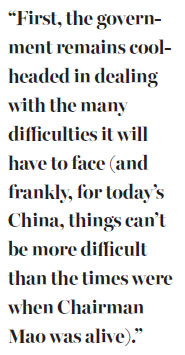Peek into Chinese politics reveals trends
Updated: 2016-03-18 08:40
By Ed Zhang(China Daily Europe)
|
|||||||||
What has emerged from crucial meetings just concluded in Beijing are four points that indicate where things are heading
Every year, China's two sessions (annual meetings of the National People's Congress and National Committee of the Chinese People's Political Consultative Conference) are not much like the parliamentary debates seen in other countries.
But the dual events (they take place in early March and each lasts around two weeks) do have an irreplaceable value as an important window for outsiders to peek into the workings of the Chinese political system.
Then what do the just-closed 2016 two sessions show to international businesspeople and investors? From watching them in Beijing, an observer may derive a few useful thoughts.

First, the government remains cool-headed in dealing with the many difficulties it will have to face (and frankly, for today's China, things can't be more difficult than the times were when Chairman Mao was alive).
There is no panic, no desperation, and finger-pointing among factions. There is no sign of beating a retreat even though many difficulties won't go away easily for the next couple of years at least.
Second, its leaders still harbor ambitious growth goals, even though they've kept saying a slowdown is inevitable and GDP isn't the only thing to gauge officials' merit.
The ambition is clearly reflected by the 13th Five-Year Plan (2016-20) adopted in the two sessions.
Some critics say China is overambitious. It doesn't need to achieve that much. But the point is that the ambition is a political design, for marshaling support from citizens on the one hand, and for setting requirements for local bureaucrats on the other. And they need tough requirements.
Third, the two events have shown that the anti-corruption campaign has not impacted the country's top economic policymaking process. In the past three years, the anti-corruption authorities have rounded up thousands officials for investigation and criminal trials, some of whom once held high positions and immense power.
But there have been few changes among China's top economic officials, leading entrepreneurs (not officials of state-owned enterprises), government think-tank leaders, and senior advisers and economists.
They have proved their integrity in the most intense and extensive anti-corruption campaign in the history of the People's Republic of China. Many of them have been involved in China's reforms since the 1980s. The same brainpower will continue to guide China's economic progress in its forthcoming transition.
That is to say, the making of economic strategies and policies has not been affected by the anti-corruption campaign, as some people have alleged.
With those people remaining in charge of China's economic machine, the scenario of a China falling into a second "cultural revolution" looks even less likely.

Fourth, new discrepancies are emerging. Changing discrepancies are a healthy sign for an economy, and can encourage the flow of resources.
Geographically, people can clearly identify two business belts taking shape in the Chinese mainland. One business belt might be called the e-commerce business belt, covering mostly the newly industrial coastal areas and a few interior urban centers.
From there, all industries and services, and indeed all aspects of life, are connected by the Internet, especially mobile Internet, and much of its business development in the future will be based on e-commerce.
In contrast, the other business belt is the old, rusty industrial belt that covers mainly a few northern and northeastern provinces, where heavy industry and mining used to be the economic pillars.
They also include old industrial cities here and there where the local resources are depleted or are no longer needed in massive quantities.
They will have a hard time reorienting their economies. And the process may last for a considerable length of time. In the process, their growth rate probably will remain below the national average by two or more percentage points.
The question remains whether a third business belt can emerge to convert some of the formerly agrarian and least developed provinces, especially those in the south, into environmentally better-protected areas to attract large numbers of middle-class tourists and retirees.
If the 13th Five-Year Plan can help keep the first business belt stable while turning the third business belt into a reality, the new revenue that their growth generates would be enough for China to cover most of the debts its local governments and companies accumulated in the past few years.
The author is editor-at-large of China Daily.
Contact the writer at edzhang@chinadaily.com.cn
Today's Top News
Inspectors to cover all of military
Britons embrace 'Super Thursday' elections
Campaign spreads Chinese cooking in the UK
Trump to aim all guns at Hillary Clinton
Labour set to take London after bitter campaign
Labour candidate favourite for London mayor
Fossil footprints bring dinosaurs to life
Buffett optimistic on China's economic transition
Hot Topics
Lunar probe , China growth forecasts, Emission rules get tougher, China seen through 'colored lens', International board,
Editor's Picks

|

|

|

|

|

|







